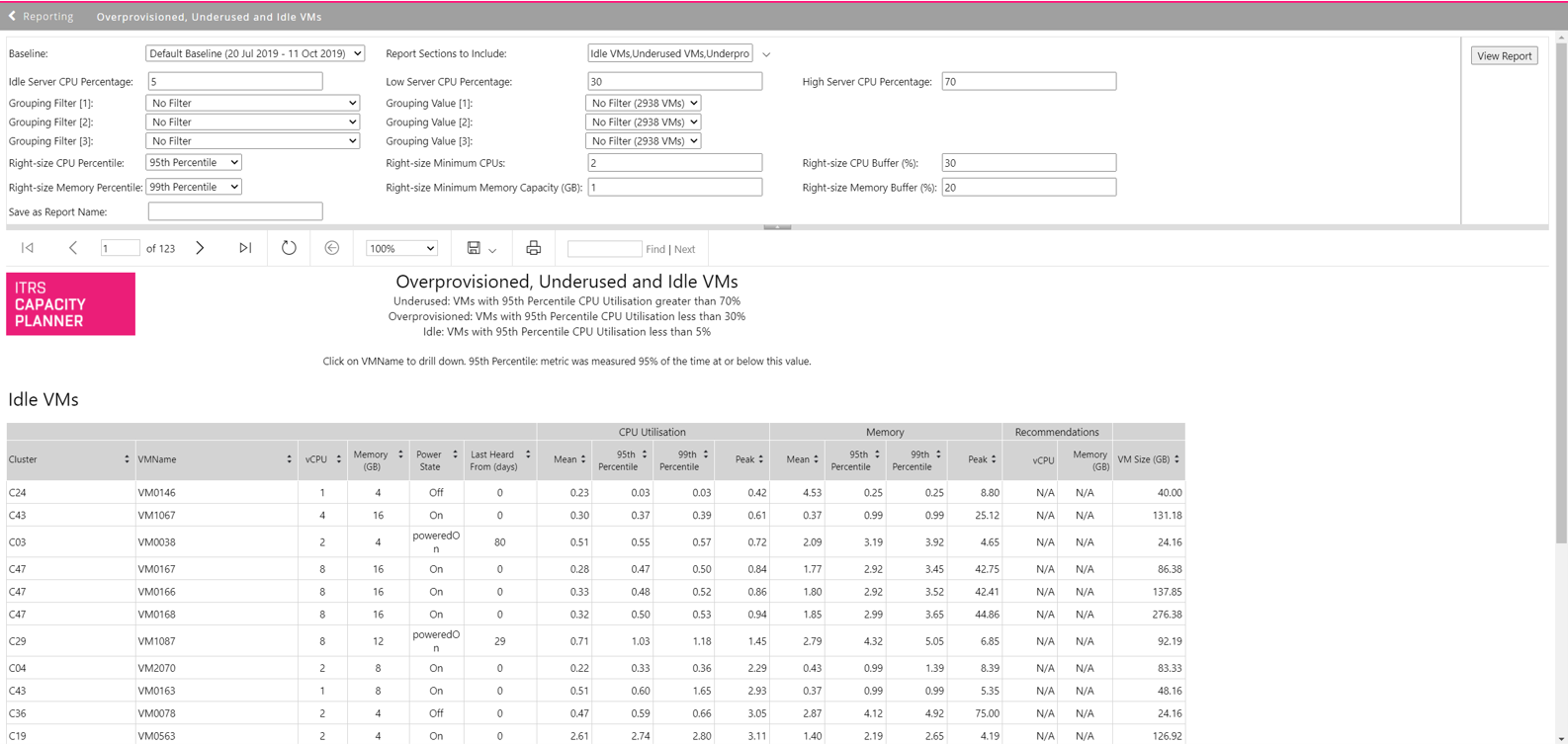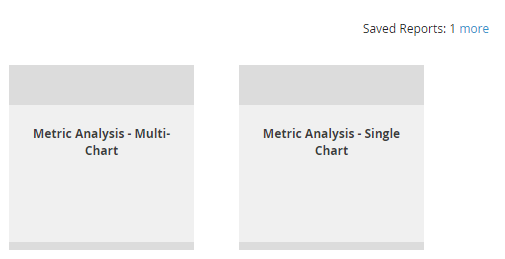Using advanced reports
Overview Copied
Reports are a very powerful and flexible feature of . Among other features, they allow you to:
- Summarise utilisation over any time period that has been modelled for a group of entities.
- Create RAG reports indicating where any breaches may have occurred.
- Analyse relationships between metrics and check how many inactive VMs you have.
- Report on cost trends and recommendations for your cloud environment.
Most reports also provide a drill-through capability to view data at successively lower levels of granularity. They can be run against different entity types (for example, physical servers, virtual machines, or hosts). Reports have configurable parameters to provide maximum flexibility, they can be saved and shared. Reports can be accessed from the Reporting accordion on the Capacity Planner project home screen.
For a full list of reports available in Capacity Planner, see Available reports.
Note
It is important to distinguish these advanced reporting features of Capacity Planner from the Infrastructure and Service reports that can be created directly from the Baseline View scenario model. To learn more, see Infrastructure and Service reports.
Interface Copied
The Report screen is divided into the following sections:
- Report parameters — parameters are used to filter the data that you want to see in your report as well as select report formatting and display options. Most reports require parameters to be input here. For more information, see Report filtering.
- Report toolbar — provides additional actions for the report. It only appears once the report is generated. The available actions are:
- Going to the first, previous, next and last page of the report.
- Going back to the parent report.
- Searching for specific text appearing in the report.
- Exporting the report.
- Refreshing the report
- Report view — where the report appears. To expand the view of the report, click the Show/Hide Parameters
 button right above the report toolbar. This is particularly helpful with reports that have a large number of parameters.
button right above the report toolbar. This is particularly helpful with reports that have a large number of parameters.

Generate a report Copied
Reports that only have default parameters are generated as soon as you open the report. Most reports require additional parameters to be entered, although default values are provided for parameters that tend to be changed less often.
To generate a report, provide the required parameters and click the View Report button. Different reports require different parameters. For more information, see Report parameters.
Reports are not automatically saved when you view them. To be able to look at the same report again, do one of the following:
- Export a report
- Define the Save as Report Name parameter. To learn more, see Save and rerun a report
Pagination Copied
When a report is generated on screen, only the first page of a report is generated to reduce processing time. If there is more than one page, a question mark ? is displayed after the total number of pages indicating the length of the report is unknown. Use the Previous/Next Page and First/Last Page buttons to move between pages.
When you move to the final page of a report, the total page count is displayed on the toolbar and the question mark is removed.
Exporting a report automatically exports all pages.

Export a report Copied
You can export a report in one of several file formats. This allows you to share the report output with anyone without direct access to Capacity Planner.
Note
Reports use a variety of layouts and styles. Not every export format works well with every report, and pagination may differ from the on-screen version of the report.
The available export formats are:
- Word
- Excel
- PowerPoint
- TIFF file
- MHTML (web archive)
- CSV (comma delimited)
- XML with report data
- Data feed
To export a report, click the export icon in the report toolbar and select the format from the drop-down list.

Your browser initiates a download of the file.
Drill-through reports Copied
In most reports, you can drill through to view data at lower levels of granularity. The drill through mechanism shows the next summary level, for example drilling down from monthly summaries takes you to daily summaries. In most cases, it is possible to drill through to the lowest level of granularity (normally 5-minutely data). If there is no data with available lower level of granularity, you will not be able to drill through any further.
Every time you drill through, a new report is generated that displays data at a lower level of granularity. If you export this data, you get the lower lever grain in your export.
To go back to the main view of the report, click the Go back to the parent report button in the report toolbar.

Search the report Copied
You can search the text of a report using the search field in the report toolbar. You can type in a name of the VM, a number, or any other text that can appear in any place of the report. This is especially useful if a report is very long and has multiple pages.
Save and rerun a report Copied
To be able to rerun a report with the same set of parameters, follow the steps:
- Input all parameters that you need to run the report.
- Provide a name for your report as the Save as Report Name parameter.
- View the report when all parameters are provided. This saves your report.
You can now access the report with your saved parameters in the following way:
- From the Reporting home page, under Saved Reports.

- From the New/Saved Report drop-down list of a report. Only saved reports of the same type will appear on this list.
If you change the Save as Report Name parameter of a saved report, a new saved report is created.
Manage saved reports Copied
To download the saved report in an XLS format or to delete it, open the list of all saved reports from the Reporting home page.
To share the saved report with users who have access to the same project, tick the Shared box.

Add a new report type Copied
If you require a custom report to be added to your Capacity Planner project, please contact your representative.